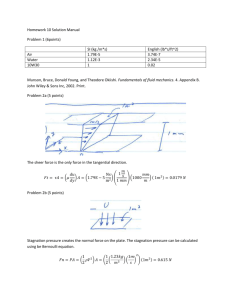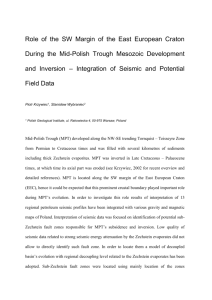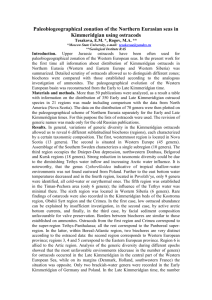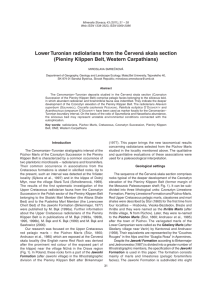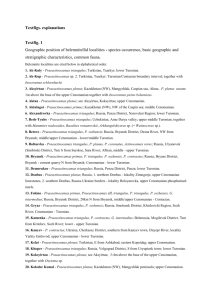from extension to inversion – a sedimentary record of jurassic
advertisement
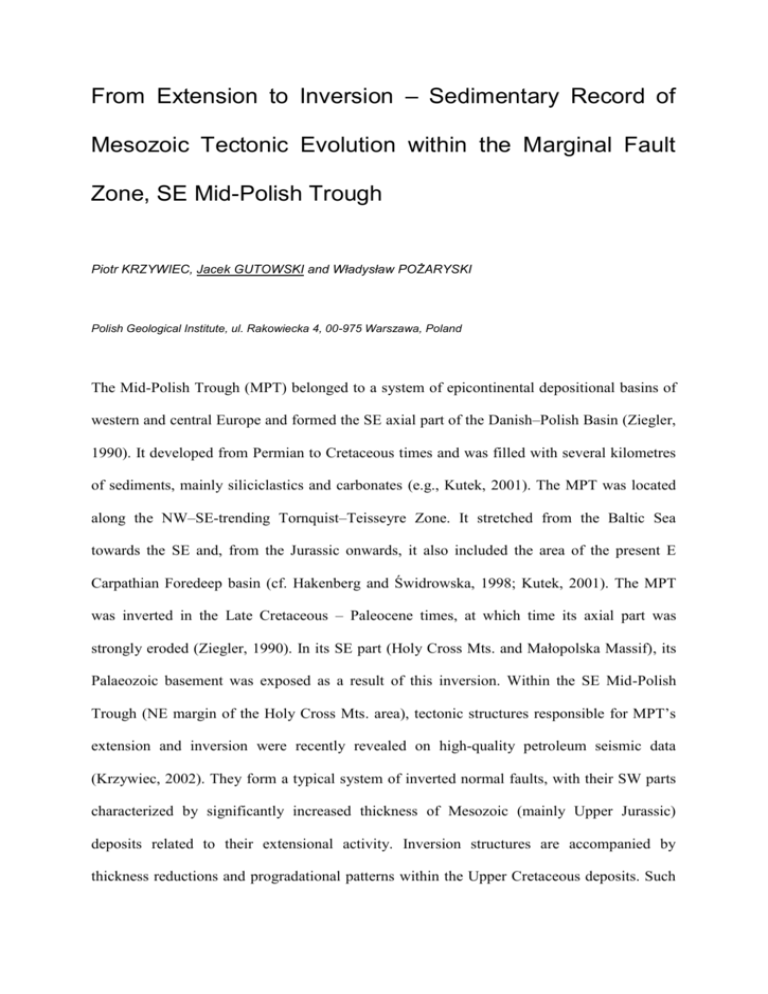
From Extension to Inversion – Sedimentary Record of Mesozoic Tectonic Evolution within the Marginal Fault Zone, SE Mid-Polish Trough Piotr KRZYWIEC, Jacek GUTOWSKI and Władysław POŻARYSKI Polish Geological Institute, ul. Rakowiecka 4, 00-975 Warszawa, Poland The Mid-Polish Trough (MPT) belonged to a system of epicontinental depositional basins of western and central Europe and formed the SE axial part of the Danish–Polish Basin (Ziegler, 1990). It developed from Permian to Cretaceous times and was filled with several kilometres of sediments, mainly siliciclastics and carbonates (e.g., Kutek, 2001). The MPT was located along the NW–SE-trending Tornquist–Teisseyre Zone. It stretched from the Baltic Sea towards the SE and, from the Jurassic onwards, it also included the area of the present E Carpathian Foredeep basin (cf. Hakenberg and Świdrowska, 1998; Kutek, 2001). The MPT was inverted in the Late Cretaceous – Paleocene times, at which time its axial part was strongly eroded (Ziegler, 1990). In its SE part (Holy Cross Mts. and Małopolska Massif), its Palaeozoic basement was exposed as a result of this inversion. Within the SE Mid-Polish Trough (NE margin of the Holy Cross Mts. area), tectonic structures responsible for MPT’s extension and inversion were recently revealed on high-quality petroleum seismic data (Krzywiec, 2002). They form a typical system of inverted normal faults, with their SW parts characterized by significantly increased thickness of Mesozoic (mainly Upper Jurassic) deposits related to their extensional activity. Inversion structures are accompanied by thickness reductions and progradational patterns within the Upper Cretaceous deposits. Such features are typical for syn-depositional tectonic activity. Thickness reduction above the uplifted basement blocks, local erosion and relatively short distance of sediment supply resulted in thickness reductions and progradational pattern in close vicinity of master reverse faults. Stratigraphic data derived from the well cores, neighbouring outcrops and regional interpretations (e.g., Gutowski, 1998; Kutek, 2001) combined with the seismic interpretation allow to recognize the following succession of tectonic/depositional events along the NE margin of the MPT’s Holy Cross segment: Permian – Triassic: initial extension stage connected with possible deposition of continental clastics followed by uplift and erosion Early – Middle Jurassic (Pre-Bathonian?): extension interrupted by minor uplift. As sediments older than the Oxfordian are absent or of very low thickness along the investigated seismic line, a more detailed interpretation is not possible. Late Jurassic: major extension and subsidence, recorded by the Oxfordian (Bathonian?)– Kimmeridgian sedimentary sequences, especially by the relatively thick Middle Oxfordian – Lower Kimmeridgian highstand systems tract, the thickness of which rapidly increases within the SW limb of the marginal fault. post-Tithonian – pre-Late Valanginian: uplift recorded by stratigraphic gap and/or subtle angular unconformity between the Upper Kimmeridgian (locally up to the Lower Kimmeridgian Divisum Zone) and the Upper Valanginian successions. Early Cretaceous: possibly prevailing extension/subsidence interrupted by minor uplift events as indicated by thickness of the Upper Valanginian – Middle Albian succession increasing towards the NW, including some sedimentary discontinuities. post-Middle/pre-Late Albian: major uplift resulted in sedimentary discontinuity and correlative erosional gap which underlie the Upper Albian transgressive sediments. Relevant erosion locally removed the Lower Cretaceous sediments and even cut the Kimmeridgian sequence down to the Divisum Zone sediments. Late Albian – Early(?) Turonian: extension related to the increased thickness of the relevant sequence within the SW limb of the marginal fault. Late(?) Turonian – Maastrichtian: inversion of the marginal fault resulted in NEdirected progradation of the Upper(?) Turonian – Maastrichtian succession and its significantly greater thickness in the NE limb of the marginal fault. References GUTOWSKI J., 1998. Oxfordian and Kimmeridgian of the northeastern margin of the Holy Cross Mountains, Central Poland. Geological Quarterly, 42, 1: 59-72. HAKENBERG M. and ŚWIDROWSKA J., 1998. Evolution of the Holy Cross segment of the Mid-Polish Trough during the Cretaceous. Geological Quarterly, 42, 3: 239-262. KRZYWIEC P., 2002. Mid-Polish Trough inversion - seismic examples, main mechanisms and its relationship to the Alpine–Carpathian collision. In: G. BERTOTTI, K. SCHULMANN and S. CLOETINGH (Editors), Continental Collision and the Tectonosedimentary Evolution of Forelands. European Geosciences Union Stephan Mueller Special Publication Series, 1, pp. 151-165. KUTEK J., 2001. The Polish Permo-Mesozoic Rift Basin. In: P.A. ZIEGLER, W. CAVAZZA, A.H.F. ROBERTSON and S. CRASQUIN-SOLEAU (Editors), Peri-Tethys Memoir 6: Peri-Tethyan Rift/Wrench Basins and Passive Margins. Mém. Mus. Natn. Hist. Nat., 186: 213-236. ZIEGLER P.A.. 1990. Geological atlas of western and central Europe. Shell Internationale Petroleum Maatschappij B.V., 239 pp.



